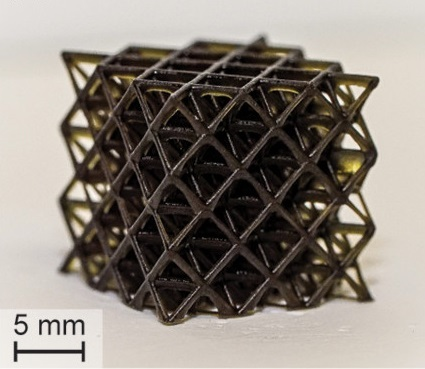Sep 17 2020
3D printing has fueled technological advances in fields spanning from medicine and art through to aerospace. But this technique is not used extensively, because a majority of 3D printers require high-energy ultraviolet (UV) light to cure liquid resins into solid objects.
 This complex object was 3D printed in about 2.5 hours using visible light. Image Credit: Adapted from ACS Central Science 2020.
This complex object was 3D printed in about 2.5 hours using visible light. Image Credit: Adapted from ACS Central Science 2020.
Visible-light curing, which would be more suitable for certain applications, such as soft robotics and tissue engineering, is quite slow.
A team of researchers has now created photopolymer resins that increase the rate of visible-light curing. The study has been published in the ACS Central Science journal.
With the aid of computer-aided design, a material is sequentially layered into a 3D shape to produce 3D-printed objects. Every layer is “cured” or solidified using UV light.
The ability to use visible light for the curing process would have certain benefits, such as reduced light scattering, reduced cost, greater depth of light penetration, and enhanced biocompatibility.
Such attributes could pave the way for novel applications for 3D printing, for example, creating multi-material structures, opaque composites, or hydrogels that contain live cells.
But visible light is lower in energy than UV, which means visible-light curing is presently too slow to be viable. Zachariah Page and collaborators wanted to identify a method to expedite this process.
The team eventually created red-, blue-, green- and violet-colored resins containing a photoredox catalyst (PRC), a monomer, an opaquing agent, and two co-initiators.
Upon absorbing the visible light from LEDs, the PRC catalyzed the transfer of electrons between the two co-initiators, which created radicals. These radicals, in turn, caused the monomer to polymerize. Through the opaquing agent, curing was confined only to the areas hit by light, which enhanced spatial resolution.
The improved mix of components enabled the team to print soft and stiff objects with mechanical uniformity, tiny features (below 100 μm), and build speeds of up to 1.8″ every hour.
While the most optimized build speed is still less than 50% that of the fastest speed achieved using UV light, it could be enhanced by boosting the intensity of light or adding other components to the resin, stated the team.
The study’s authors acknowledged support from the U.S. Department of Defense and the Welch Foundation.
Journal Reference:
Ahn, D., et al. (2020) Rapid High-Resolution Visible Light 3D Printing. ACS Central Science. doi.org/10.1021/acscentsci.0c00929.